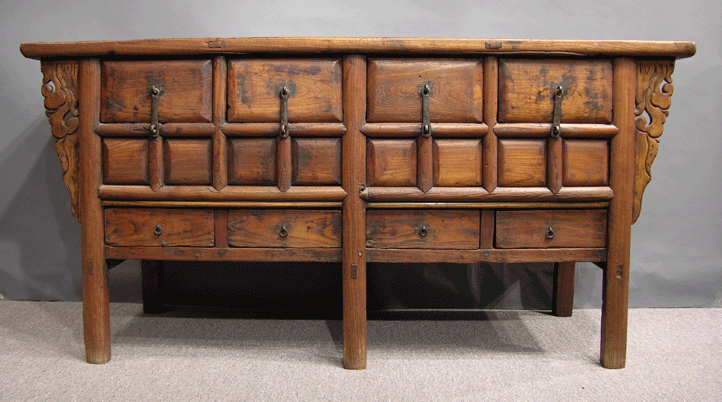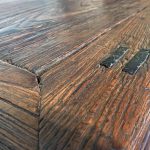
Circa 15th C; Sophora (Huai) wood, pine or other soft wood for secondary framework; Shanxi.
35” h. 70” w. 25” d.
This buffet is rare because not many Chinese furniture this ancient, made of an extinct wood, survived in excellent condition to reach Western market today. The wood, the Sophora, became extinct after the Ming period due to the tree’s slow growth and the wood over-used. It was the wood of choice by Ming literati as furniture building material because it is very dense, naturally resistant to moisture and insect damage, and has beautiful deep grain patterns that made painted decorations unnecessary.

This chest is constructed in the traditional mitered, mortise-and-tenon method, with double tenons penetrating through to the surface of the frame members. This method adds stability to the chest. The top is made with a thick slab of Sophora and has a floating panel in the middle. It shows deep grains with a few cracks as it is characteristic of this wood to crack a little when first cut but afterwards stabilizes and does not warp, important for a piece of furniture that might have to move from place to place.
The wide chest has four big drawers at the top and four narrow ones at the bottom, with a row of four panels in-between. The rows are separated by “sword ridge” stretchers, and the middle panels are each separated by a decorative “sword ridge” strut. The front panels of the top drawers and the middle decorative panels are not flat but beveled, indicating superb craftsmanship. The top drawers once pulled out, expose storage space hidden behind the middle panels, making the buffet also a coffer. Spandrels are fitted to each side of the front and back below the top. Those in front have a pierce carving while those at the back are plain. The metal fittings on this coffer are original.
This piece survived in excellent condition due to its strong building material, Shanxi region’s relatively dry climate, and it being geographically guarded by the Great Wall nearby. It has the kind of superb structure, elegance of style and natural luster that not only pleased the literati of that period, but no doubt in the 1400s prompted Marco Polo to send back examples to Spain, which might have started a furniture revolution in that country!